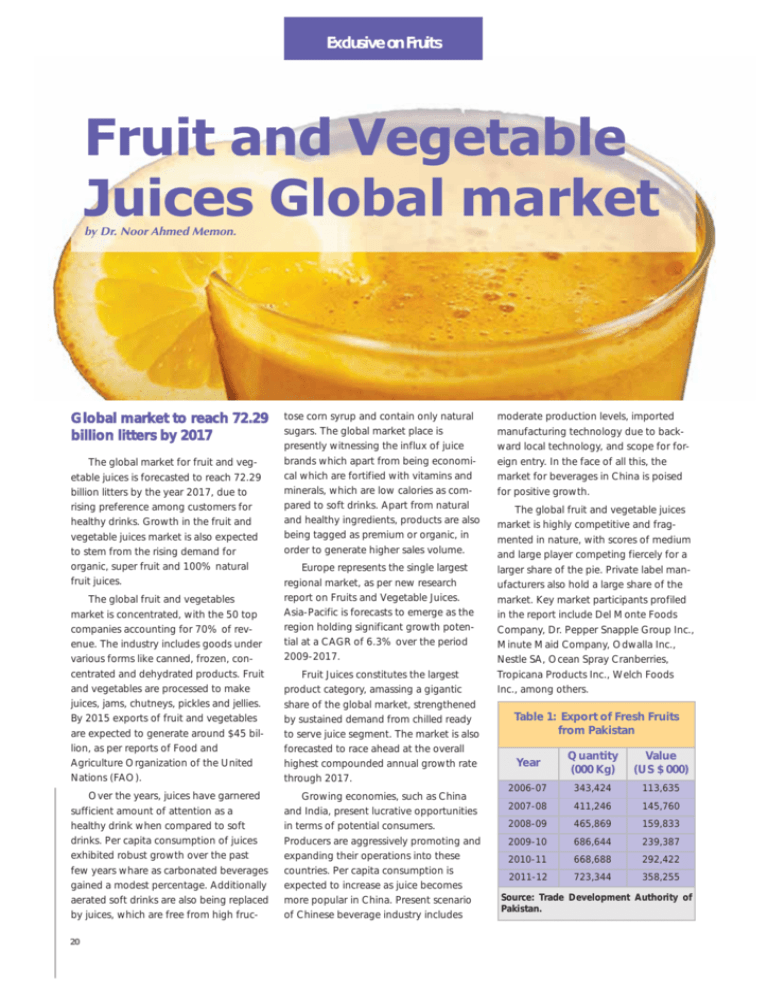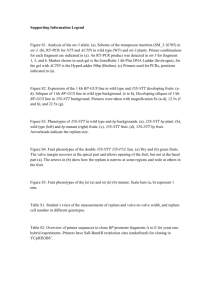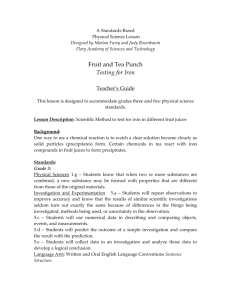Fruit and Vegetable Juices Global market
advertisement

Exclusive on Fruits Fruit and Vegetable Juices Global market by Dr. Noor Ahmed Memon. Global market to reach 72.29 billion litters by 2017 The global market for fruit and vegetable juices is forecasted to reach 72.29 billion litters by the year 2017, due to rising preference among customers for healthy drinks. Growth in the fruit and vegetable juices market is also expected to stem from the rising demand for organic, super fruit and 100% natural fruit juices. The global fruit and vegetables market is concentrated, with the 50 top companies accounting for 70% of revenue. The industry includes goods under various forms like canned, frozen, concentrated and dehydrated products. Fruit and vegetables are processed to make juices, jams, chutneys, pickles and jellies. By 2015 exports of fruit and vegetables are expected to generate around $45 billion, as per reports of Food and Agriculture Organization of the United Nations (FAO). Over the years, juices have garnered sufficient amount of attention as a healthy drink when compared to soft drinks. Per capita consumption of juices exhibited robust growth over the past few years whare as carbonated beverages gained a modest percentage. Additionally aerated soft drinks are also being replaced by juices, which are free from high fruc20 tose corn syrup and contain only natural sugars. The global market place is presently witnessing the influx of juice brands which apart from being economical which are fortified with vitamins and minerals, which are low calories as compared to soft drinks. Apart from natural and healthy ingredients, products are also being tagged as premium or organic, in order to generate higher sales volume. Europe represents the single largest regional market, as per new research report on Fruits and Vegetable Juices. Asia-Pacific is forecasts to emerge as the region holding significant growth potential at a CAGR of 6.3% over the period 2009-2017. Fruit Juices constitutes the largest product category, amassing a gigantic share of the global market, strengthened by sustained demand from chilled ready to serve juice segment. The market is also forecasted to race ahead at the overall highest compounded annual growth rate through 2017. Growing economies, such as China and India, present lucrative opportunities in terms of potential consumers. Producers are aggressively promoting and expanding their operations into these countries. Per capita consumption is expected to increase as juice becomes more popular in China. Present scenario of Chinese beverage industry includes moderate production levels, imported manufacturing technology due to backward local technology, and scope for foreign entry. In the face of all this, the market for beverages in China is poised for positive growth. The global fruit and vegetable juices market is highly competitive and fragmented in nature, with scores of medium and large player competing fiercely for a larger share of the pie. Private label manufacturers also hold a large share of the market. Key market participants profiled in the report include Del Monte Foods Company, Dr. Pepper Snapple Group Inc., Minute Maid Company, Odwalla Inc., Nestle SA, Ocean Spray Cranberries, Tropicana Products Inc., Welch Foods Inc., among others. Table 1: Export of Fresh Fruits from Pakistan Year Quantity (000 Kg) Value (US $ 000) 2006-07 343,424 113,635 2007-08 411,246 145,760 2008-09 465,869 159,833 2009-10 686,644 239,387 2010-11 668,688 292,422 2011-12 723,344 358,255 Source: Trade Development Authority of Pakistan. Exclusive on Fruits The research report titled “Fruit and Vegetable Juices’ forecast that during the years 2009-2017 major consumer countries are US, Canada, Japan, Europe, AsiaPacific, Latin America, and the Middle East. Pakistan Fruit Juice industry The beverage industry of Pakistan divided into two broad categories such as production of Juices, Squashes and Syrups and the other kind producing aerated beverages. Pakistan is one of the few countries of the world, where a variety of fruits are grown in cool temperate climate such as apples, pears, plums, cherries, and those grown in the warm temperate climate are apricots, figs, grapes, pomegranates, melons and the rest in the tropical and sub-tropical climate like bananas, mangoes, dates, guava and citrus fruits, which are available throughout the year. While the fruits grown in temperate climate are produced in Baluchistan and NWFP, tropical and subtropical fruits are mostly grown in Punjab and Sindh. The various varieties of fruits are grown over an area of about 758 thousand hectors. The annual production of fruits in Pakistan is estimated at around 6.11 million tonnes, of which only 723 tonnes were exported in 2011-12. Whereas the rest of them were either fruits are mango, kinno, apple, dates and consumed locally or perished. oranges. Dubai is the biggest market for Pakistani mango, followed by England Export of fresh fruits and Saudi Arabia. India is the only biggest Overall export of fresh fruits has witnessed a steady growth. Fresh fruits exports were valued at US$114 million in 2006-07, which rose to US$358 million in market for Pakistani dried dates. Fruit juices production Fruit juices acts as a nutritious bever- 2010-12. Export of fresh fruits from age and can play a significant part in a Pakistan are given in Table 1. healthy diet because they offer a variety of nutrients found naturally in fruits. Pakistan is exporting fruits to Afghanistan, India, Russian Federation, Being one of the best forms of nature's UAE, Germany and UK. The exported power foods, they are really valuable in Table 2: Exports of Juices From Pakistan Quantity: 000 Kg Value: Rs. 000 Juices Orange Juice Frozen Orange Juice not Frozen Other Orange Juice Grape Fruit Juice Citrus Fruits 2011-12 Quantity Value 2010-11 Quantity Value 2009-10 Quantity Value 5,343 837,072 5329 549,968 5247 137 11,184 702 86,032 98 458,765 7,877 3,948 198,578 2986 229,308 1697 108,151 894 87,006 74 6,303 273 21,860 -- -- 15 1,228 25 2,662 Other Citrus Fruits 42 4,999 160 15,690 100 8,039 Pineapple Juice 541 51,281 284 25,434 61 4,402 2 192 13 1,547 -- -- 151 13,466 124 9,575 15 1.028 Tomato Juice Grape Juice Apple Juice 1,687 196,460 1,113 61,607 218 15,497 Juice of Single Fruits / Vegetable 30,764 1,673,069 21,231 1,351,952 13,765 779,676 Mixture of Juices 6,946 576,176 5,191 393,722 2,583 185,425 Total 50,455 3,649,483 37,222 2,709,651 24,082 1,593,382 Source: Federal Bureau of Statistics, Government of Pakistan. Sept - Oct-2012 21 Exclusive on Fruits the search for health. Scientific studies have also claimed that the antioxidants found in most fruits and vegetable juices can help lower a person’s risks of developing Alzheimer’s disease. Antioxidants are naturally occurring substances found in most plants and have the potential to help combat heart diseases and fight cancer. At present 38 units producing fruit juices, syrups and squashes are working in the country. Nestlé Pakistan Ltd, Mitchells Fruits and Benz Industries are the major fruit juices, syrups and squashes units of the country. Most of the existing fruit juice units are being operated in Lahore, Bahawalpur, Karachi, Hyderabad, Hattar (NWFP), Loralai, and Sargodha. Around 92% of the total fruit juice market is accounted for 250 ml Tetrapack. The rising cost of raw material and packing materials etc. have resulted in the price increase of fruit juice products in the local market. Export of fruit juices: Pakistan exports considerable quantities of fruit juices, mainly to Afghanistan, India and Middle East countries. Export of juices of orange, pineapple and other fruits increased from 24.41 tonnes worth Rs 15.58 billion in 2009-10 to 50.45 million tonnes worth Rs. 3.65 billion in 2011-12 as given in Table-2. Pakistan is exporting frozen orange juice to Cyprus, The Netherlands, India, Thailand, Srilanka, Bangladesh, Italy and UAE. Country-wise export of frozen Orange juice from Pakistan is given Table-3. With price competition in the international market, Pakistani exporters find it hard to compete due to constant rise prices of sugar and packaging material. Despite the above handicaps some major units have managed to export their products in foreign market at competitive prices. Table 3: Country-wise Export of Orange Juice (Frozen) 2011-12 Quantity Value Country 2010-11 Quantity Value India 1754 249,043 2,003 190,548 Bangladesh 172 26,434 171 16,718 Sri Lanka 350 58,348 262 28,187 Thailand 139 24,313 445 44,845 U.A.E 436 75,434 102 18,458 Cyprus 294 36,312 621 67,251 Iran 500 101,346 481 44,179 Italy 229 27,627 -- -- Nether Lands 999 165,755 960 110,308 Greece 94 17,400 -- -- Afghanistan 49 5,628 -- -- Indonesia 59 6,827 -- -- All other Countries 268 42,605 284 29,474 5,343 837,072 5,329 549,968 Total Source: Federal Bureau of Statistics, Government of Pakistan. Table 4: Production of Fruits (major items) (000 Tonnes) Fruits Citrus Fruits Mango Banana Apple Guava Apricot Peach Pears Plums Grapes Pomegranate Dates Total 2007-08 2008-09 2009-2010 2010-2011 2,294 1,754 158 442 539 240 82 24 73 75 57 557 6,295 2,132 1,728 157 441 512 238 84 24 67 76 61 566 6,086 2,150 1,846 155 366 509 194 54 20 57 65 62 631 6,109 2,151 1,845 155 367 510 194 54 20 57 66 62 632 6,113 Source: Federal Bureau of Statistics, Government of Pakistan. 22 Quantity: 000 Kg Value: Rs. 000






